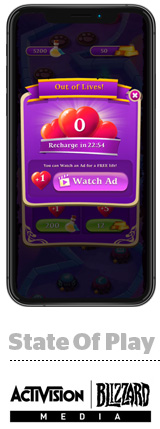
What does a 13-year-old have in common with a retired woman and a middle-aged man? They all play mobile games.
“There’s a misconception that the gaming audience is just kids,” said Brian Ames, president of Activision Blizzard Media (ABM), an advertising division housed within game publishing giant King. “The reality is, though, that gamers are quite a diverse group.”
And advertisers are starting to realize that. The global gaming audience clocks in at 2.2 billion, with nearly 200 million people in the United States alone, according to estimates from mobile market researcher Newzoo. That’s not niche.
But scale isn’t the main selling point for marketers. They also want engagement and what Ames calls “lean-in attention,” which gaming can provide. The average King user spends roughly 36 minutes per day playing “Candy Crush,” “Bubble Witch” and other King games.
And so, Activision Blizzard Media, which officially launched in mid-June after roughly six months of incubation within the King mothership, has focused much of its attention on rewarded ads, including “Journey,” a proprietary rewarded video unit that allows players to continue playing in exchange for viewing a brand message.
“We’re trying to build ads that are well integrated within the games, because if you’re respectful of someone’s time and attention, then the player will actually pay attention and that will pay dividends,” Ames said.
Video completion rates for rewarded video across King’s portfolio are often more than 90%, and half of King players opt into rewarded video experiences at least once every day in each of the King games they play.
King also ran lab tests with biometrics research firm iMotions comparing brand metrics for ads in “Candy Crush” with similar ads in other popular social and video apps. Ad recall and unaided message association were 18% and 2.1 times higher in “Candy Crush”.
“This is an environment where people are spending 20 or 30 minutes a day, and they appreciate the opportunity for ads if they need a color bomb, for example, in ‘Candy Crush’ to help them along,” said Jonathan Stringfield, head of global business marketing, measurement and insights at Activision Blizzard Media.
Stringfield, who joined ABM in January after nearly five years as Twitter’s director of US marketing insights and analytics, tests the bejesus out of King’s ad experiences to make them as compelling as possible for King’s advertisers and 270 million monthly active users. At the top of his list is probing the question of video ad duration on mobile.
The ad industry is coalescing around the notion that shorter videos, often just six seconds, are always better, because users get annoyed by longer video ads, skip as soon as they’re able or just tune out altogether.
“And to be clear, that’s 100% true – I conducted a lot of that research while I was at Twitter,” Stringfield said. “But the caveat a lot of people don’t think about is that it’s perhaps only true within the context of a feed-based social environment.”
And so Activision Blizzard Media is “looking to flip the script a bit” by testing longer videos, Stringfield said. Not every environment encourages the same sort of mindset.
“Maybe it’s the case that people will not just be OK with but actually enjoy a 30-second ad, if they have the right incentive,” he said. “These are the types of things we’re looking at and testing right now.”
This post was syndicated from Ad Exchanger.


More Stories
Scroll Media boosts in-game advertising with new feature
Kiwi filmmaker spotlights media struggles at top global awards
T-Mobile Has Appointed Kristin Harrer As Senior Vice President and Chief Brand Officer